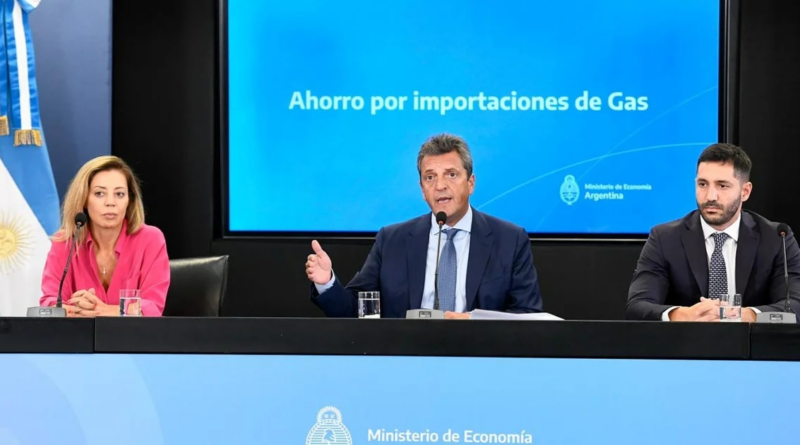While the IMF insists on reducing subsidies, the government assures that there is only one rate hike left until the end of the year
The Government maintains, at least for now, its own original road map for the rest of the year on rate hikes after the International Monetary Fund warned of the need accelerating cuts in subsidy spendingespecially energetically. So far this year, this government spending bill has cut, in real terms, close to 20 percent.
In its latest communique formalizing a technical deal, the IMF drew attention to what the government’s fiscal policy would have to look like in the coming months as a condition to make the disbursements promised in August and November. One item that always appears in the organization’s preferences menu for evaluating the path of public spending is its subsidies.
“The primary fiscal deficit target for 2023 remains unchanged at 1.9% of GDP. “Achieving the target requires further tightening of fiscal policy in the second half of this year, supported by a range of agreed revenue and expenditure measures, protecting priority social and infrastructure programs,” the IMF said.
He added: “On the expenditure side, efforts are still needed to contain wage growthupdate energy rates to better reflect changes in production costswhile improving the system scaling; and strengthening spending controls through better targeted social assistance and greater streamlining of current transfers to provinces and state-owned companies.”
Skirmishes with the Monetary Fund over the issue of tariffs have been a constant in technical discussions since the original negotiation began in mid-2021 and was settled in March last year. The IMF is funding a rapid adjustment in energy subsidy spending and had forecast, in the technical review completed in March this year, savings for 2023 equivalent to 0.5% of GDP and that subsidies coverage 40% of energy costs, compared to 70% they covered last November.
Progress signals that in 2022 energy subsidies ended up representing the 1.9% of the Gross Product. The cut expected for this year in the baseline scenario drawn up by the Monetary Fund and the Government placed this amount in 1.5% of GDP. Halfway through the year, the Ministry of Economy had even estimated that it could end up with a subsidy budget of less than 1 unit of GDP.
The original plan, they say in the Ministry of Energy, states that in Octoberstill in full development of the electoral calendar, it should take place a common audience to determine what the November ticket increasescheduled as the only and last one to remain until 2023.
It may not be a calendar set in stone anyway. As they assured infobae official sources, the financial team is Assessing these days how the price roadmap will continue, after the advance call of the Monetary Fund. No clues yet if he will predict some revaluation of utility prices before that end-of-year period.
The original plan states that a public hearing should be held in October to determine what the increase is on the November ballot. In any case, this log would be in reanalysis
The subsidy budget cut, anyway, already has a marked course this year. A report by the Rate and Subsidy Observatory (which is part of UBA’s Interdisciplinary Institute of Political Economy) found that “in the first half of 2023, subsidies are falling in real terms by 17.3% per year, explained by a real reduction in transfers 4.4% in energy 20.1% and 17.4% in water,” they noted.
On the other hand, it calculated that “in June 2023 the prices paid for domestic electricity demand cover 100% of costs for N1 (the one with the highest income), 14% for N2 (higher subsidy coverage) and 18 % for the N3 household (median income). For natural gas, PIST (entry into the transport system) prices paid by users cover 53% of the gas supply costs for N1, 16% for N2 and 20% for N3 households,” the observatory reviewed .
The economist Julian Readenergy specialist, measured by the latest increases applied to electricity bills, that users without subsidies had an increase of 6.3% compared to July and 523% nominal compared to August 2022before segmentation is done.
In real terms, discounting inflation, the highest income range of users saw an increase in final bills 190% albeit a slight monthly decline. In concrete figures: in August a household without subsidies will pay for electricity $11,533. Given this level of notoriety, it’s more than what it paid for January 2019.
In real terms, discounting inflation, the higher income spectrum of users saw a 190% increase in their final electricity bills in the last year and are paying more than they were in January 2019
for the houses N2 and N3for their part, in nominal terms in August they had an increase in his final account 3% y 2.7% respectively compared to July, always for consumption of 300 kilowatts per month and of 65% y 83% compared to August 2022. In real terms they decreased compared to August 2022 (-23% y -15%) and compared to the previous month (3.7% and 4%)Red pointed out. They pay, at final ticket prices, $3,051 and $3,338, respectively. At current prices, a year ago they both paid about $3,900.
Of all household electricity users registered with RASE, 33.2% have no subsidies, 49% belong to the segment with the highest subsidy coverage, and middle income earners account for 17.6%. In the Metropolitan Area of Buenos Aires (AMBA) these percentages change to 45%, 34% and 20%, respectively.
For natural gas, meanwhile, 39% pay the full cost of the service, 36% have the largest possible subsidy and 24% are in the middle.
Continue reading:
#IMF #insists #reducing #subsidies #government #assures #rate #hike #left #year
